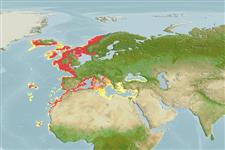Elasmobranchi (squali e razze) (sharks and rays) >
Rajiformes (Skates and rays) >
Rajidae (Skates)
Etymology: Dipturus: Greek, di = two + Greek, pteryx = fin (Ref. 45335).
Issue
Raja macrorynchus Rafinesque, 1810 is considered as valid in Eschmeyer (Eschmeyer (CofF ver. Sep. 2011: Ref. 88002): Ref. 88002), although many authors put it in (questionable) synonymy with R. batis Linnaeus, 1758.
Ambiente / Clima / Range
Ecologia
; marino demersale; distribuzione batimetrica 100 - 1000 m (Ref. 4426), usually 100 - 200 m (Ref. 4426). Subtropical, preferred 19°C (Ref. 107945); 69°N - 12°N, 30°W - 42°E
Eastern Atlantic: Norway, Iceland, the Faroes to Senegal, including western Mediterranean and western part of the Baltic. Extirpated by trawling from much of its former range (Ref. 27438).
Length at first maturity / Size / Peso / Age
Maturity: Lm 160.0 range ? - ? cm
Max length : 285 cm TL maschio/sesso non determinato; (Ref. 35388); common length : 100.0 cm TL maschio/sesso non determinato; (Ref. 3261); Peso massimo pubblicato: 97.1 kg (Ref. 40637)
Spine dorsali (totale): 0; Spine anali 0; Raggi anali molli: 0. Snout very long and pointed; length before eyes 2,5-4,0 times distance between them; disc broadly rhombic with acute outer corners; upper surface and underside smooth in young, partly prickly in larger specimens; no thorns on disc, a row of 12-18 thorns along tail; 40-56 tooth rows; upper surface olive-grey or brown with a variable pattern of light spots, underside ashy-grey to blue-grey (Ref. 3167).
Benthic species in shelf and slope waters with a wide tolerance for depth and temperature (Ref. 4426). Found in coastal waters mainly within the 200 m range (Ref. 3167). Feed on all kinds of bottom animals, large individuals prefer fish (Ref. 3167). Oviparous. Distinct pairing with embrace. Young may tend to follow large objects, such as their mother (Ref. 205). Mate in spring and the egg capsules are laid during the summer. Eggs are oblong capsules with stiff pointed horns at the corners deposited in sandy or muddy flats (Ref. 205). Egg capsules are 10.6-24.5 cm long and 5.0-14.5 cm wide (Ref. 41250). About 40 eggs per individual are laid annually (Ref. 41250). Flesh is marketed fresh or smoked (Ref. 35388).
Oviparous, paired eggs are laid. Embryos feed solely on yolk (Ref. 50449). Egg-cases laid in spring and summer, very large (Ref. 3167). Distinct pairing with embrace. Young may tend to follow large objects, such as their mother (Ref. 205). Eggs have horn-like projections on the shell (Ref. 205).
McEachran, J.D. and K.A. Dunn, 1998. Phylogenetic analysis of skates, a morphologically conservative clade of elasmobranchs (Chondrichthyes: Rajidae). Copeia 1998(2):271-290. (Ref. 27314)
IUCN Red List Status (Ref. 115185)
CITES (Ref. 94142)
Not Evaluated
Threat to humans
Harmless
Human uses
Pesca: scarso interesse commerciale; Pesce da pesca sportiva: si
Informazioni ulteriori
BibliografiaAcquacolturaProfilo di acquacolturaVarietàGeneticaFrequenze allelicheEreditarietàMalattieElaborazioneMass conversion
Strumenti
Special reports
Download XML
Fonti Internet
Estimates of some properties based on models
Phylogenetic diversity index (Ref.
82805): PD
50 = 0.5000 [Uniqueness, from 0.5 = low to 2.0 = high].
Bayesian length-weight: a=0.00363 (0.00193 - 0.00683), b=3.17 (3.01 - 3.33), in cm Total Length, based on LWR estimates for this species & (Sub)family-body (Ref.
93245).
Trophic Level (Ref.
69278): 3.5 ±0.6 se; Based on diet studies.
Resilienza (Ref.
69278): Molto basso, tempo minimo di raddoppiamento della popolazione più di 14 anni (K=0.06; tm=11; tmax=51).
Prior r = 0.14, 2 SD range = 0.03 - 0.58, log(r) = -1.97, SD log(r) = 0.72, Based on: 1 M, 1 K, 1 tgen, 1 Fec records
Vulnerability (Ref.
59153): Very high vulnerability (86 of 100) .
